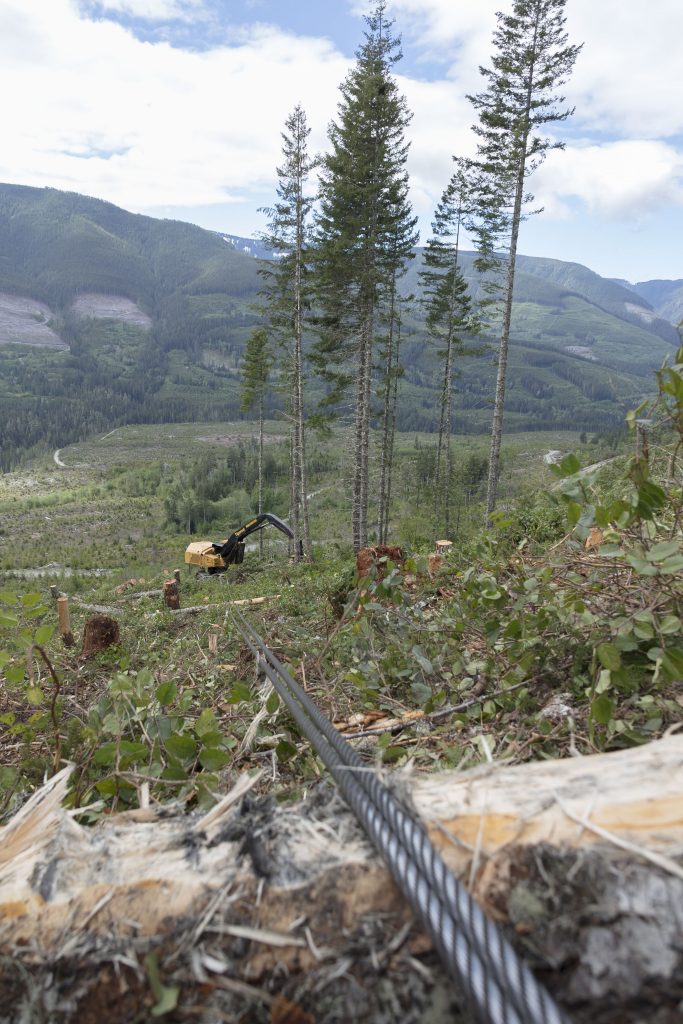
Features
Forestry Management
Harvesting
Column: Mechanized-harvesting machines could improve worker safety
Dec. 6, 2017 - It’s an exciting time for British Columbia’s steep-slope-harvesting forestry workers and employers. Approximately 25 new mechanized-harvesting machines equipped with winch-assist technology are operating in the province, and another 20 are anticipated to be put into use over the next two years on British Columbia’s rugged, often treacherous forested landscape.
December 6, 2017 By John Ligtenberg
 Photo courtesy WorkSafeBC It’s an exciting time for British Columbia’s steep-slope-harvesting forestry workers and employers.
Photo courtesy WorkSafeBC It’s an exciting time for British Columbia’s steep-slope-harvesting forestry workers and employers.These new machines can be used to fell, process, and forward wood to the roadside.
Advancements in mechanized steep-slope harvesting have the potential to improve occupational health and safety by getting more workers off the hill. But new technology also presents unique hazards and risks that employers need to identify, assess, and account for to prepare workers to operate new machinery safely.
Hand-falling is a dangerous occupation. The injury rate for manual tree fallers in B.C. in 2016 was 27.3 – by comparison the overall provincial injury rate for the same year was 2.21. Out of 127 accepted time-loss claims in 2016 for manual tree fallers, 30 were for serious injuries – 24 per cent. New technology that reduces the risk hand fallers face by allowing them to stay inside a cab while performing their duties, or operate equipment remotely, is a significant development for the safety of these workers; fully remote-controlled equipment is still relatively uncommon in B.C. and is currently limited to some yarders, carriages, and cameras on grapple yarders.
WorkSafeBC is keeping pace with these mechanical advancements by developing new health and safety resources so employers can ensure this equipment meets the requirements of the Workers Compensation Act and Occupational Health and Safety Regulation.
A free guide available at worksafebc.com titled Understanding the Requirements for Mobile Logging Equipment in British Columbia, was developed by WorkSafeBC’s Forest Industry Advisory Group (FIAG). Additionally, FIAG created new guidance to aid officers’ on-site inspections identifying specific issues to look for, such as appropriate risk assessments, steep-slope plans, equipment inspections, and operator protective structures.
Mechanized harvesting and manual falling are both areas of focus in WorkSafeBC’s 2017 High Risk Strategy for forestry. From Q1 to Q4, safety inspections of worksites with mechanized-harvesting equipment have focused on an employer’s maintenance work plan, lockout procedures, three-point-contact procedures, and steep-slope assessment and plans. WorkSafeBC officers also inspect to ensure workers are properly trained to use new machinery and that the equipment is being used in accordance with manufactures’ specifications. Inspections are conducted by prevention officers with the goal of reducing serious and fatal injury rates in the areas with the highest risk to forestry workers.
FPInnovations, the research arm of the forest industry, has been actively involved in researching advances in steep-slope and tethered equipment and have supported two advisory groups: one for employers utilizing this equipment and another for manufacturers bringing this equipment into B.C. The main goals of these groups are to reduce safety incidents, improve margins and access to fibre. FPInnovations expects to release a study in the fall of 2017, commissioned by WorkSafeBC, about steep-slope harvesting and tethered equipment.
As the number of new harvesting machines increases on B.C.’s forested worksites, so will our knowledge about how to ensure workers are well prepared to safely operate this equipment.
John Ligtenberg is an occupational safety officer with WorkSafeBC.
Print this page